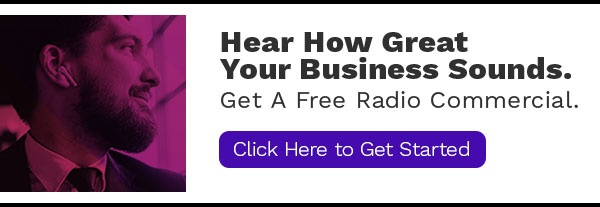 There are many ways for Tampa Bay small business owners to advertise. Options include local newspapers, local magazines, local television, and online. But to achieve the “3-Rs” of advertising success, Reach, Recall, and Return, no other medium delivers results as effectively and efficiently as advertising on Tampa radio.
There are many ways for Tampa Bay small business owners to advertise. Options include local newspapers, local magazines, local television, and online. But to achieve the “3-Rs” of advertising success, Reach, Recall, and Return, no other medium delivers results as effectively and efficiently as advertising on Tampa radio.
"I didn't think radio advertising would work. I was not a believer," says David Perritt, Regional Operations Manager of Lakewood National Golf Club in Lakewood Ranch, Florida.
Mr. Perritt's opinion changed after he experimented with advertising on Tampa radio stations when the club first opened in January 2017.
"I have been extremely pleased with the results," he says. "The data shows just how successful radio has been working for us. Choosing the right Tampa radio stations was crucial."
There are 27 radio stations that service Tampa Bay. Each provides a unique blend of music, information, and entertainment. Some stations focus on politics or sports. Some play country music. Some play the hits. Some play classic rock. Some are on the AM dial. Some are on FM.
Most small business owners, though, could not afford to advertise on all stations. So, how can they decide which are the right ones? It will be determined by a marketing objective.
First: Determine A Marketing Objective
An effective advertising campaign on Tampa radio stations needs a specific marketing objective. The objective should correspond with an advertiser’s key challenges or opportunities. The objective will influence which radio stations to purchase, the length of the campaign, the timing of the advertising, as well as the length and the content of the commercials.
It is possible that over time, a business could have many different marketing objectives, but it is a proven, best practice for each campaign to focus on one. The objective selected should be crucial to the continued success of the business.
There are, generally, two types of marketing objectives:
Branding objectives focus on convincing consumers to believe something about a product or business. For instance, a financial planner in Brandon might want adults approaching retirement to regard her firm’s annuity plans as the safest way to ensure worry-free living.
Promotional objectives are used when a business owner’s goal is to encourage the target consumers to take a specific action, quickly. They are usually time sensitive with a specific call-to-action. For example, a Pizza Restaurant in Clearwater might want working moms to order take-out dinner on their way home from work taking advantage of a two-for-one promotion.
A marketing objective should distinctly identify the target customer. Age and gender alone do not provide enough insight to determine radio station selection or commercial content. Examples of a well-defined target might be:
- Wine enthusiasts
- Working Moms
- Under-employed college graduates
- Do-It-Yourself-Self Home Depot shoppers
- Heavy internet users
- Men planning to propose
- Pickup truck owners
A business owner may have several different target consumers. For instance, a local bank might need to target homebuyers for mortgage products; entrepreneurs for commercial loan products; smartphone users for mobile banking products; and retirees for certificates of deposit.
Although each of these targets is a viable prospect for the bank, they are likely to have little in common including their choice of radio stations due to different lifestyles and stage of life.
With a well-defined marketing objective, a business owner can be certain every element of an advertising campaign on Tampa radio is designed to deliver the right message to the right audience at the right time.
Second: Identify The Best Radio Stations.
Tampa Bay radio listeners are fiercely loyal to their favorite stations. Despite numerous listening options, the typical listener tunes-in to two stations each week. So, to create a successful advertising campaign, a business owner must identify those radio stations that attract the target consumers defined by their marketing objective.
For instance, a chain of Pizza restaurants might want to target the 264,000 moms in Tampa Bays who work full-time. It takes just three local radio stations to reach the majority of these moms. This information, alone, allows the restaurant owner to narrow the choice of Tampa radio stations from 27 to three.
The question now becomes, which combination of these 3 stations should ultimately be chosen for the ad campaign? The answer is determined by the type of marketing objective.
Third: Choose Between Reach or Frequency
A branding objective involves creating or modifying a consumer’s belief. To do this successfully requires the repetition and reinforcement of the business owner’s marketing message. This repetition is referred to as frequency. Achieving the necessary frequency can be accomplished by scheduling commercials on as few as one or two Tampa radio stations over a longer time frame.
A promotional objective, on the other hand, requires the largest number of target consumers to be exposed to a marketing message. This is referred to as reach. If a certain number of consumers in Tampa Bay ready to buy, then obtaining the greatest reach possible among those listeners will increase the odds of creating a sale.
Achieving the necessary reach can be accomplished by advertising on multiple Tampa radio stations generally over a shorter time frame. Note, each additional radio station that is purchased expands the overall reach of the campaign.
The owner of the pizza chain, in our example, has a promotional objective: to encourage working moms to order take-out on their way home from work tonight. Because this type of objective requires reach, then budget permitting, the campaign should include the three radio stations that comprise the majority of the target consumers.
 This pizza example is not fictional. For the past 33 years, advertising on Tampa radio has helped Hungry Howie's grow from just 20 locations in the Tampa Bay area to 210 throughout the state.
This pizza example is not fictional. For the past 33 years, advertising on Tampa radio has helped Hungry Howie's grow from just 20 locations in the Tampa Bay area to 210 throughout the state.
The primary benefit advertising on Tampa Radio offers to Hungry Howie's marketing effort is repetition.
"Radio provides us the affordable frequency we need to hit hungry consumers over the head enough times for our message to sink in," says Barry Devine, who has been handling Hungry Howie's marketing since the first store opened in Tampa. "We want to be top of people's mind when they are driving home from work and don't feel like cooking."
To reach people before dinner time, Hungry Howie's dominates afternoon drive time on Tampa Bay radio 52 weeks a year.
"Eighty percent of our advertising runs weekdays between 3pm and 8pm" says Sandra Harley, Devine Advertising's media planner and buyer. "To build our frequency we depend on commercials that are 15-seconds or shorter plus traffic report sponsorships."
"Everything we do needs to build frequency of message for Hungry Howie's," she continues. "My success equation for media buying is simple," she says. "What you say, times the number of times you say it."
Mr. Devine adds, "The first couple of times someone hears the Hungry Howie's message on Tampa radio, it's like planting seeds. Adding frequency is like watering the seeds to make them grow. We can only buy that type of frequency on radio."
Rules of Thumb:
- Reach more people with a radio advertising campaign by spreading the budget over multiple stations. Used for promotional objectives.
- Increase the number of times a consumer is exposed (frequency) to an advertising campaign by using fewer radio stations. Used for branding objectives.
When a Tampa Bay small business owner considers advertising on Tampa radio, the information needed to make an informed station selection can be secured from a reputable radio account executive. This information includes reach and frequency data from Nielsen; local listener profiles from Scarborough; and consumer insights from Gfk MRI.





